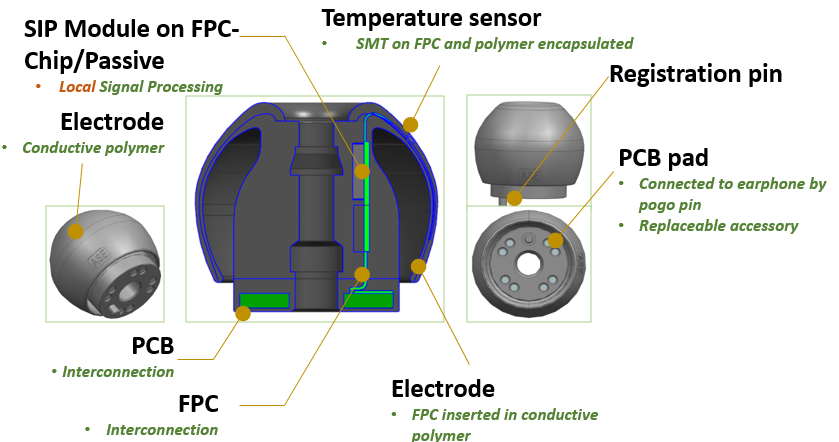
Blog
3D Composite Polymer Package for Digital Health Wearable Devices
Kaihung Wang
IoT envisions connection of trillions of devices around the world to data centers, and enables applications with the network connected. Nevertheless, SiP opportunities stay with two fundamental requests: miniaturization benefits and valuable market size. These are by no means for comprehensive listing of the IoT devices that will be deployed in the next ten years. Therefore, wearable applications are selected here because of their rapid increase in market sizes, their importance to the end customers, and their potential for the business growth from the SiP.
In addition, it is predicted that the global medical staff gap will over 9 million in the upcoming years. The aging population is increasing by 3% per year. It will continuously derive issue of medical service shortage ,and large gap of resource distribution between urban and rural become serious. Resource arrangement in hospital and medical center will be crucial. Therefore, a sensor device should be easily and comfortably carried by patient. It would be also capable to provide accurate bio signal detection and information processing which is expected to be with great market potential.
Therefore, one of the most expected potential extensive feature on wearable devices is Digital Health Device. According to the definition by FDA, digital health is the broad scope which includes categories such as health information technology, wearable devices, tele-health & telemedicine, and personalized medicine. And clearly wearable devices with carry-able bio-detectors will be the most critical trigger of this coming mega wave.
Wearable-Digital Health Device: Opportunities and challenges
As of today, these features has been well enabled and on the consumer medical devices such as blood pressure monitor, hearing aids, blood glucose meter, body composition analyzer, ECG (Electrocardiography) device, sleep monitor, etc. In recent years, the use of telehealth has gained more traction from a small base with specific purpose, e.g., sports and fitness. It has been widely adopted in smart watches and wristbands due to its great advantage of convenience.
Nevertheless, to accelerate the migration of digital health market to next level requires, new challenges coming up:
1. Data collection and accuracy
Different types data covered with optical, piezoelectric, electrochemical signals and resulting from the interaction of the analyze with the biological elements. To minimize the surrounding interference to those signals, the signal transduction protection between detectors and analyzing processors will be priority. However, considering the space limitation, the detected signal from detectors and decoders are far separated. It causes inevitable risks in data accuracy.
2. Re-structurable 3D SiP
Except miniaturization, a customized 3D SiP appearance will be expected as the a next level challenge. While more and more features with complicated circuits and peripheral components are integrated, system designers are looking forward more flexibility of placement, stacking and structure. Compare with the traditional cubic outline, a customized 3D SiP overmolded by re-structurable material will allow further flexibility to customers.
3. User comfortability
To achieve the of 7/24 monitoring, a skin-friendly, flexible and stretchable material over the sensors as well as the interface to human body, in addition, the material are expected to be conductive and able to continuously detect bio-signals will be crucial.
3D Composite Polymer Package
Apparently, the traditional molding material and packaging process may not be able to all those satisfaction. It requires a systematic innovation to integrate the sensors, processor and peripheral components re-structurable, flexible and conductive material.
The world’s first smart in-ear-bud packaged in polymer is illustrated in below. This in-ear bud is capable of detecting ECG (electrocardiography) signal, heart rate, as wll as body temperature, from human ear canal. The bud is designed to be connected to a typical wireless ear-set, which transmits signal through Bluetooth. It is assembled with advanced packaging technologies, including SiP (system in package) module for system miniaturization, flexible substrate for conforming to the 3D structure, and molding with composite polymer for bio-contact. This material is heterogeneous integrated, such that it encapsulates the functional active and passive fillers, allows the bio-signal to be detected. The earbud conforms to the exterior ear canal, and is friendly to sensitive human skin.

As shown below, FPC is overmolded within the non-conductive composite polymer with well protection. And, the exposed copper foil on the FPC tail will be covered by conductive composite polymer instead as the electrode to detect the bio-signals from users’ ear canal.

This innovative package is unique in bringing the integration of the sensors and front-end circuitry to the outside mechanical parts of a device. This integrating approach not only reduces space and weight, but also is inherently high fidelity and high consistency for bio-signal measurement.
More information regarding the Composite Polymer Package can be found in the ECTC article entitled “Smart Biofeedback Earbud Achieved by SiP with 3D Composite Polymer Package“.

Arthur 2023-05-24
I agree with your points about the future of Wearable-Digital Health Device. I think we're in for some exciting changes.